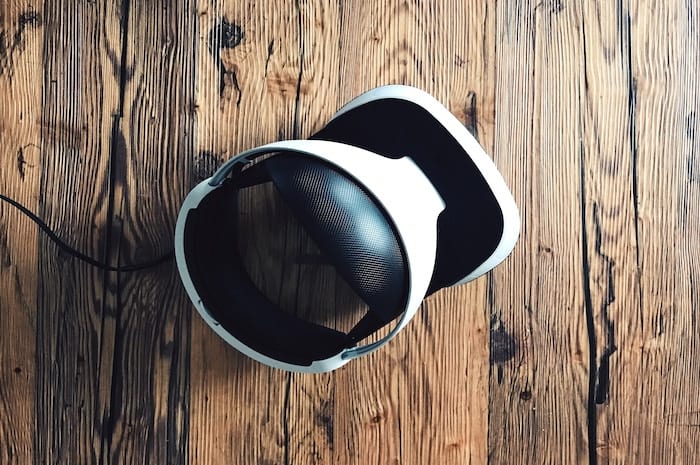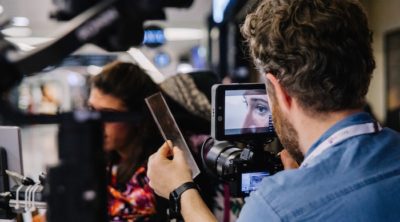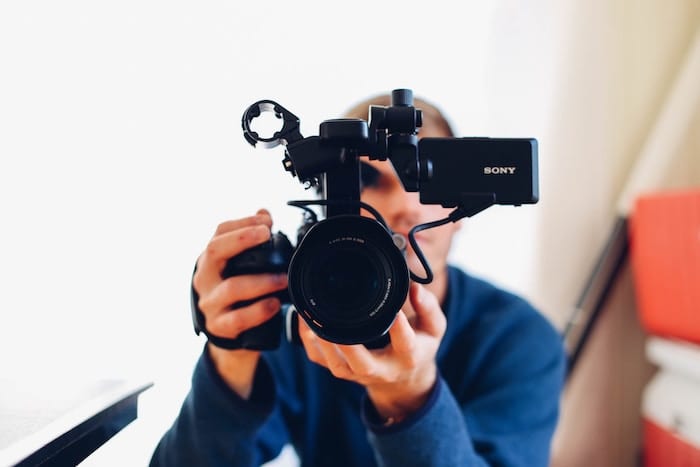< Back to all posts
Marketing with VR and AR: The Future of Video
If you’ve spent any time paying attention to the latest marketing trends in tech and video then you’ve likely heard the terms VR and AR get tossed around pretty frequently. At the speed advancements in technology move, it can sometimes be a bit overwhelming to keep track of every single, specific detail. Especially in video and video marketing, areas constantly undergo change. Marketing with VR and AR may very well be the future of the industry, but it’s important to cover the basics of both and some of their modern applications.
VR Overview
VR, short for Virtual Reality, completely takes the user into the virtual world. You’ve most likely heard of products like the Oculus Rift, Sony Playstation VR, Google Cardboard, or Samsung Gear VR. For most VR setups, headsets block out all light and sound from the existing world, completely altering the perception of the person wearing it.
The headset effectively leaves you completely isolated from the natural world around you. In doing so it provides a totally immersive experience for the user. Examples of VR programs include roller coasters, mountain climbing, dog sledding, and deep-sea swimming.
The isolating, immersive experience can make some users feel as though they are moving, whether that’s the steep ascent and descent of the rollercoaster or the vertigo of peering over the ledge of a mountaintop. Think about the videos you’ve probably seen on social media of someone’s elderly family member reacting wildly while wearing a VR headset; Grandma isn’t the only one excited by the prospects of this tech that is further infiltrating our media-sphere.

AR Overview
AR, or Augmented Reality, is a bit different. Though both forms of technology have similarities, in some respects, AR is quite the opposite of VR. Instead of removing users completely from their current space, AR applications take our existing environment and alters (or, ahem, “augments”) it by adding to it.
AR takes existing environments and enhances them with elements like graphics, animations, and pop-ups. Also, unlike VR, it’s a much less isolated experience. AR invites users to experience the “real” world together, but now in completely new ways. What’s more, AR is readily available for most people through smartphone and tablet apps that operate directly through the device’s cameras.
The best example of AR in action in recent years would probably be Pokémon Go. The game uses the camera on mobile devices as well as location and tracking services on smartphones to encourage people to explore the immediate world around them. The game adds loot, treasure, and Pokémon throughout the world for users to find and “catch.”
Let’s not forget Instagram and Snapchat, a pervasive social media example of AR. These apps use the device camera and facial recognition technology to add various, interactive animations to live photos and videos. From dog faces and bunny ears to “big-head” funhouse mirror effects, both apps are constantly updating the offerings for users.
Exciting Applications for Both Technologies
Both VR and AR offer exciting potential, but to do…what? Everyone loves a good “CEO with dog ears” but the investment in time, technology, training and budget begs more ROI on immersive media. VR offers opportunities to introduce products to new audiences, explain complex concepts, give virtual tours and add serious bang for your buck to large events. AR can also offer exciting possibilities to add to exhibitions, conferences and anyone who owns a smartphone.
Fortune 500 companies and small tech startups are both investing time, energy and money into developing VR technologies. The cost of headsets is steadily declining and more accessible to the average consumer. In the age of Amazon reviews, who wouldn’t want to “try before you buy” a product?

With so much media out there everyday on every imaginable device permeating the user’s landscape, carving out a unique space for your brand can be tough. VR and AR submerge your target audience into what YOU want them to experience and see. VR has fantastic tools to map where the user’s eyes or mouse go, so that each campaign launch can be tweaked and improved upon.
Here’s a small sampling of other ways to use the technology:
- VR “seats” at concerts and sporting events (the NBA has already made a VR viewing experience available this season).
- More effective training experiences: VR flight simulations, up close and interactive medical procedures, etc.
- A VR digital tour of an organic farm or a faraway tourist destination.
- Integrated AR maps for better GPS navigation.
- Product “experiences” via AR: Think about being able to really see a product or digitally try it on before buying it.
Shooting for VR
For starters, anytime you’re shooting anything for VR you’re going to need to be able to shoot 360 video. That means every angle and direction is recorded simultaneously using multiple cameras or, more likely, an omnidirectional camera. These types of cameras are made by most major tech companies and are readily available for consumers.
When shooting 360 video for VR it will be stereoscopic , meaning 3D objects and depth are included. Many people experience intense nausea or vertigo while using VR. The sensory deprivation can throw off an individual’s equilibrium, and the experience is just so foreign that our body may be trying to catch up with what the mind is perceiving.
With that in mind, using the right equipment to ensure your shots are steady becomes even more imperative. What’s more, multiple cameras, angles, and directions means you’ll have to be hyper-aware of your stitch lines.
Always keep the viewer in mind. Realize that 360 video can limit certain intricate details, and that sometimes the best user experience is the simple, expected route. At least until VR capabilities improve even more.
Shooting for AR
With AR, on the other hand, much of the advanced implementation will happen on the development side. So many tried and true filming techniques will apply in these situations. Standouts of course will be proper framing and smooth, steady movements as well. The user experience will benefit greatly and it will ensure that any new elements, animations, or points of interaction can be properly implemented.
While your current jobs list probably isn’t overflowing with requests to shoot optimally for VR and AR, it’s important to recognize industry trends and where technology may eventually lead to new things. After all, it wasn’t that long ago that using real film became somewhat obsolete outside of artistic endeavors or kitschy hobbies. You should always prepare yourself with an eye towards the future. And in the mean time, stick with Crews Control for all of your video production needs!







Leave a Reply